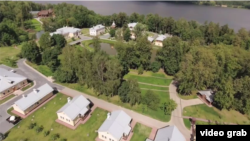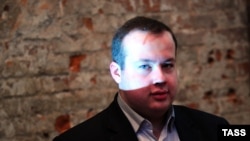MOSCOW -- Georgy Alburov stood knee-deep in snow, having just posed as a tourist to gain access to an exclusive ski resort in southern Russia.
Guards had checked his trunk as he drove in, but they failed to spot the drone -- a device that has become key to the opposition’s efforts to spotlight corruption among President Vladimir Putin's closest allies.
Under the watchful eye of security cameras, Alburov scrambled up a five-meter snowbank and used it as a launching pad to fly the drone toward its target: a sprawling Krasnodar Krai mountain estate reputedly owned by Prime Minister Dmitry Medvedev.
The drone brought back just the type of footage that Alburov, a key activist for opposition politician Aleksei Navalny's Anticorruption Foundation, was seeking. It revealed sweeping, snow-capped grounds replete with luxuries -- mansions, a private helipad, a swimming pool, and a spa complex -- and would set the Russian Internet alight.
It was packaged with other shots of sumptuous residences, edited into a video that claimed to expose Medvedev's hidden property empire, and uploaded to YouTube, where it has been viewed more than 26 million times in under a year.
"It turned out magnificently," recalls Alburov. "We practically landed the drone on the glass roof. There was literally 20 centimeters left."
Too Close For Comfort?
In anticorruption activists' efforts to get a glimpse behind the gated palaces of the Kremlin elite, perhaps no tool has been as valuable for the opposition as drones fitted with cameras. The video allegations that Medvedev held properties worth billions, for example, prompted mass antigovernment protests.
A slew of videos alleging illicit riches held by federal ministers, lawmakers, and billionaire tycoons close to Putin has helped Navalny carve out a large online following while being effectively blocked from state media.
It is the dizzying aerial videos of estates, rustic Italian villas, and bucolic vineyards in particular that have transformed potentially plodding investigations into visual -- and viral -- sensations.
"It's a really serious factor in terms of views and the popularity of our videos," says Alburov from the Anticorruption Foundation's fifth-floor offices in a business center in southern Moscow. "All of our videos with flights are much more widely watched than videos with talking heads."
There are signs, however, that authorities may be moving to close the window that drones offer into the secretive life of the elite. Regulations are becoming more strict, recently requiring all drones weighing over 250 grams to be registered with the state, and flight plans to be submitted stating the time, location, and purpose of the flight.
It is now a finable offense to fly a drone in Moscow without special permission from authorities, while it is strictly prohibited to fly over crowds or facilities like power plants or military installations. And newspaper reports suggest that the National Guard is testing "cannons" or other means to shoot drones down if they stray too close to strategic sites.
And while regulations on how to register drones are not yet in place, meaning in practical terms it is not possible to register them, there has been a spate of recent calls from the Transport Ministry, lawmakers, and the National Guard to significantly raise fines for nonregistration, to ban drones outright, and to develop and install jamming systems to disrupt drone flights.
Alburov sees these calls as transparent efforts to stymie his anticorruption work. "If they simply pass laws to secure their dachas, we won’t accept these laws and we will continue to fly over the dachas all the same," he says.
High-Flying Days Over?
It wasn't always so difficult to fly drones in Russia: their number grew rapidly from 2013 when technological advances made them available for mainstream use.
Around that time, photographer Amos Chapple was able to use a drone to peer behind the walls of the Kremlin in the heart of the Russian capital.
It was only later that Muscovites, in 2016, noticed that Global Positioning System (GPS) signals were being scrambled around the Kremlin. The Federal Guard Service (FSO), which protects the Kremlin, has declined to explain the signal jam, but experts such as Grigory Bakunov have argued they likely are intended to prevent the use of drones.
In their own early bid to get aerial footage, Navalny activists in 2013 sent a man with camera up in an ultralight aircraft to get a birds-eye view of official excess. Their first unmanned effort also flew that year -- a quadcopter with a GoPro camera taped to its underbelly. In the spring of 2016 came the current drone, nicknamed 'Volodya', which has enjoyed high-flying success.
"Unbelievably, it turned out to be pretty popular," Alburov says. "People liked the idea that it’s possible to get over the fence -- not us ourselves, but by using a drone or some kind of technology to have a look what a bureaucrat has on the other side of the fence."
But flights over sprawling estates -- specifically one purportedly belonging to Medvedev outside the town of Plyos, northeast of Moscow, in 2016 -- pushed the drone to its limits.
WATCH: Drone Footage Of A Luxury Estate, Which Purportedly Belongs To Dmitry Medvedev
"We had to fly across the whole Volga River, and then fly over 100 hectares belonging to Medvedev," Alburor recalls. "We could well have lost signal and come down on the duck house," he adds, referring to a duck house on a pond that became a symbol of the investigations into official extravagance, and led protesters to start regularly waving rubber ducks at rallies.
"That time we were lucky: we filmed everything and returned back and got 5 million views in a few days," he says.
Preparing For Takeoff
Now hoping to reach more out-of-the-way targets, Navalny earlier this month announced on his YouTube channel that his foundation was raising funds for a more powerful drone. Within a matter of days, he had raised 479,000 rubles from his 1.6 million YouTube subscribers.
The new drone will have its work cut out for it, but Alburov is not grounding plans to use drones in future investigations.
The next target? Alburov declined to give specifics. "I can’t tell you about that now, because we are still planning to film there," he says, revealing only that they will be in Moscow Oblast, which rings the capital.


